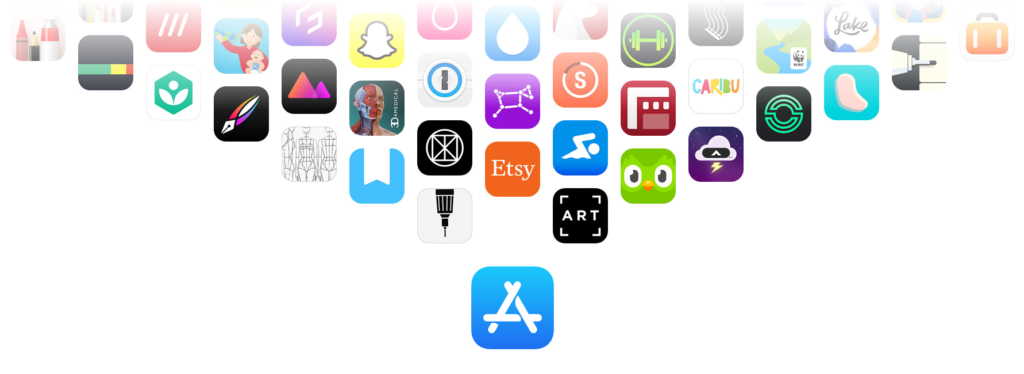Launching an app requires more than design and development. It demands creative, relentless promotion. Even brilliant ideas get lost in the noise of the app stores unless users know them, trust them, and spread the word. This mobile app marketing guide is a detailed roadmap that will show you how to get your app noticed, win downloads, and avoid common mistakes.
1. Update the Definition of Your Target Audience to Create Marketing Communication
User needs evolve, so your communication should evolve too.
Success comes from knowing exactly who your users are and why they should care about your app. Identify their pain points, behaviors, and habits.
Even if you already have a well-defined target audience and mobile app marketing strategy, over time and with new insights, you may start emphasizing different benefits of your app than originally planned.
How to Do It:
- Continuously refine your user personas based on usage analytics, survey feedback, user interviews and industry trends.
- Create descriptions, slogans, and value propositions that show how the app will benefit the user. Keep your marketing communication up-to-date.
- Use segmentation in your analytics tools (i.e., Firebase) to see which groups are most engaged and pivot communication accordingly.
- Your marketing communication should include: the why behind creating the app, its specific benefits, for whom it’s intended, and what differentiates it from similar solutions on the market (that’s your UVP – Unique Value Proposition).
Mistakes to Avoid:
- Value proposition too general (“Saves time!” vs. “Helps busy parents track their kids’ health appointments.”). Vague messaging speaks to no one, wastes budget, and risks blending into the background. Clearly state in one sentence: “This app helps [audience] solve [problem] by [unique benefit].”
- Casting the net too wide. “Our app is for everyone” is a death sentence, because it makes your marketing unfocused.
- Using jargon instead of simple, user-centered benefits.
- Being finished with marketing communication. With new feedback and in an ever-changing market, marketing communication is always a work-in-progress. Regularly check what works best in your message.

2. Optimize for App Stores (ASO)
Just like websites rely on SEO, your app depends on App Store Optimization (ASO) to be discoverable. Think of your app store listing as your storefront. If it doesn’t grab attention instantly, potential users will scroll past.
How to Do ASO Well:
- There are many tools that will help you identify high-traffic but low-competition keywords (AppTweak, Sensor Tower, Data.ai)
- Test different icons and screenshots with A/B testing (Google Play lets you do this).
- Encourage reviews by asking for ratings after a positive user experience (e.g., after completing a task or milestone). More on the subject here: How to Achieve High App Ratings.
Avoid:
- Stuffing as many keywords as possible into your description (it feels tempting, but don’t do it). Over-optimizing or writing clunky copy turns off potential users and may even reduce ranking.
- Using only text-heavy screenshots; visuals + benefit-driven captions convert better.
3. Build Hype Before Launch
The moment you sign a contract with a software development company should be a moment you tell the world about the app (even if it’s scary).
You’re building something important.
Don’t let it pass unnoticed. Build anticipation, recognition and trust well in advance.
Your mobile app marketing efforts should begin weeks (or even months) before your app officially goes live. This pre-launch buzz ensures you don’t launch into silence but instead to an already curious and engaged audience.
How to Do It:
- Create a landing page with a waitlist. Offer rewards for early sign-ups.
- Use teaser videos on social platforms (TikTok, YouTube Shorts, and Instagram Reels).
- Offer beta access (for example via TestFlight) to collect early feedback and testimonials.
- Be present in the community you’re engaging with (depending on your target audience: Reddit, Facebook, Instagram, LinkedIn, Discord groups).
Avoid:
- Keeping the app secret until launch day. Momentum comes from anticipation, not surprise.
- Don’t let imposter syndrome get the better of you — it’s normal that you don’t feel confident advertising something that hasn’t been built yet (you don’t feel you’re offering any value at this point). But by engaging with your early adopters and showing determination, you’ll show your confidence, earn their trust and attention.
- Ignoring early testers – engaged beta users often become your first advocates.
4. Make Sharing and Referrals Easy
Your best promoters are your existing users. When people genuinely love a product, they naturally want to share it. Let them do it easily and turn your happy users into a self-sustaining growth engine. This is because people trust recommendations from friends more than any ad.
How to Do It:
- Add one-tap share features inside the app (e.g., “Share your score,” “Invite a friend,” or “Send this checklist”). Duolingo nailed this with its “streak sharing” feature. Users proudly post their progress on social media, fueling friendly competition and encouraging others to join.
- Create referral incentives: give users extra features, credits, or premium time for bringing friends.
- Make sharing natural and rewarding — the easier it is to tell others, the faster your app grows.
What to Avoid:
- Avoid making sharing feel forced or spammy — users should want to share, not feel pressured.
- Avoid complicated referral programs with unclear rules or delayed rewards.
- Never fake virality with bots or purchased referrals — authenticity drives sustainable growth. Once you break people’s trust, it’s difficult to regain it.

5. Use Multi-Channel Promotion for Your Mobile App Marketing
The best promotion strategies combine multiple touchpoints: social media, paid ads, content marketing, and strategic partnerships all amplify reach.
How to Do It:
- Map your target audience to platforms: e.g., teens → TikTok, professionals → LinkedIn.
- Repurpose your content: one blog post can become an email, a short video, and a carousel post.
- Test small ad budgets ($50–$200) to find the best-performing channels.
- Get out into the real world. While promoting your app online is irreplaceable, offline presence adds credibility, memorability, and human connection that digital ads alone can’t deliver. If relevant, run or take part in workshops, conferences, and meetups.
- Be always ready with a QR code that leads to your app’s listing in the app stores. How to create a QR code to your app? One of the best ways is to use a smart links tool, such as OneLinkToApp. Thanks to this solution, you don’t need to create separate links to your App Store, Google Play store and website. It’s all in one QR code.
Avoid:
- Relying on a single channel (e.g., only Instagram ads). Platforms change algorithms, leaving you vulnerable.
- Overextending across too many channels with no focus — pick 2–3 and master them first.
6. Collaborate With Niche Communities
These highly engaged audiences are often more receptive to discovering and trying new apps that solve a problem they care about. By collaborating with these communities, you can reach motivated users, build credibility, and generate authentic word-of-mouth growth.
How to Do It:
- Identify where your users hang out: subreddits, Discords, Slack groups, specialized Facebook communities.
- Join as a genuine member, answer questions, and provide value before introducing your app.
- Run AMAs (Ask Me Anything) or offer free resources tailored to that group.
Avoid:
- Posting promotional links without context — this gets flagged as spam.
- Assuming big audiences are always better. Smaller, highly engaged communities often drive more sign-ups. Even if your app has the potential to become a global product, it may be easier to start locally and then upscale to new markets than try to appease everyone.
7. Monitor Analytics and Adjust Your Mobile App Marketing Strategy Accordingly
Track and test your ideas. Depending on the metrics, you can do it in:
- the App Store / Google Play Dashboard (installs, uninstalls, ratings, reviews, conversion rates, keyword performance),
- an analytics tool such as Firebase (how people use the app and when they drop off: in-app behavior, engagement, retention),
- or build a custom KPI in your admin panel (tracking business-specific performance or internal goals, e.g., number of lessons completed, etc.).
How to Do It:
- Track acquisition (where users come from), activation (what gets them hooked), and retention (how long they stay).
- Run cohort analyses to see how new users behave compared to older ones.
- Focus on metrics that show real engagement, loyalty, and revenue potential, for example DAU/MAU (Daily Active Users / Monthly Active Users). The DAU/MAU ratio gives you an engagement score — e.g., if you have 100,000 MAU and 30,000 DAU, your ratio is 30%. A higher ratio means users keep coming back (a “sticky” app).
- Measure how many users continue using your app after a set period (Day 1, Day 7, Day 30).
Avoid:
- Obsessing only over download numbers. If users churn after one day, you’re wasting money.
- Tracking too many vanity metrics. Don’t be fooled by big numbers that don’t move your business forward (landing page views or social media followers do tell you a lot about your exposure, but they don’t yet mean income).
8. Invest in PR and Storytelling
Even without a PR team, you can secure coverage by telling a great story. Journalists, bloggers, and podcasters are constantly looking for fresh, authentic, and inspiring stories. Show yourself (and your app) to the world. By talking about the journey that led you to create an app, you’re gaining trust and connection. After all, your app is not just a tech product, but an idea brought to life by real people for real people.
Building a mobile app can feel overwhelming if you’re on your own. This is why we guide you in the process step by step. Let’s talk!
contact us nowHow to Do It:
- Identify media outlets covering your niche.
- Craft a personal founder story — why you built it, including the “a-ha moment” when it occurred to you that others might benefit from it, and include clearly what problem it solves and for whom (for guidance, see Step 1: defining your target audience and marketing communication).
- Include visuals, data, or user testimonials in your pitch.
- Offer journalists early access or exclusives.
Avoid:
- Sending generic mass emails. Personalization always wins.
- Talking only about “features.” Focus on human stories and impact.
9. Check How Others Did It (Learn from Real Examples)
There’s no single mobile app marketing formula for instant success. Every app, audience, and niche is different — but studying what others have done can spark ideas, reveal unorthodox tactics, and help you avoid common mistakes. Inspiration doesn’t mean copying; it means understanding what worked (and what didn’t) and adapting it to your own app and audience.
How to Do It:
- Analyze apps similar to yours in the App Store / Google Play: note how they describe their value proposition, screenshots, reviews, and ratings.
- Read case studies, interviews, and blog posts about successful app launches. Many startups have gone viral without huge investments initially relying on organic sharing and niche community buzz.
- Observe unorthodox marketing tactics: gamification, referral loops, influencer outreach, or creative PR campaigns.
- Adapt ideas to your audience rather than copying exactly — context matters.
Mistakes to Avoid:
- Assuming one strategy will work for your app just because it worked for another. What worked for Bumble or Duolingo may not work for a productivity app targeting professionals.
- Copying blindly without considering your app’s audience or ignoring your own analytics and user feedback.
- Spending too much time looking for inspirational ideas and planning without action. Focus on one or two ideas at a time and put them into practice. Experiment quickly, learn, and iterate instead of creating elaborate, over-complicated strategies.
Summary
Launching an app is only half the battle – getting it noticed is key. This mobile app marketing guide shares proven strategies, from defining your audience and optimizing your app store listing to leveraging user referrals and telling compelling stories. Follow these steps to attract, engage, and retain users while avoiding common promotion pitfalls.
Contact us today to see how we can help your app gain traction, retain users, and grow sustainably.





